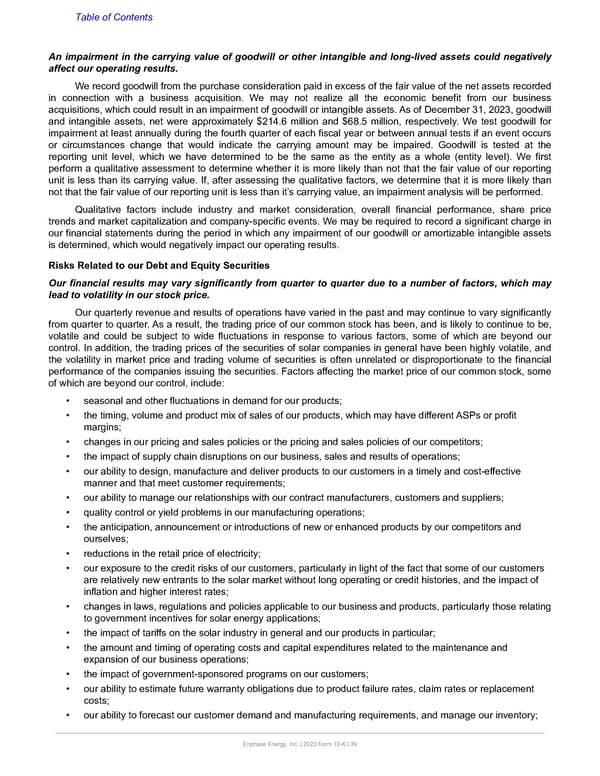Table of Contents An impairment in the carrying value of goodwill or other intangible and long-lived assets could negatively affect our operating results. We record goodwill from the purchase consideration paid in excess of the fair value of the net assets recorded in connection with a business acquisition. We may not realize all the economic benefit from our business acquisitions, which could result in an impairment of goodwill or intangible assets. As of December 31, 2023, goodwill and intangible assets, net were approximately $214.6 million and $68.5 million, respectively. We test goodwill for impairment at least annually during the fourth quarter of each fiscal year or between annual tests if an event occurs or circumstances change that would indicate the carrying amount may be impaired. Goodwill is tested at the reporting unit level, which we have determined to be the same as the entity as a whole (entity level). We first perform a qualitative assessment to determine whether it is more likely than not that the fair value of our reporting unit is less than its carrying value. If, after assessing the qualitative factors, we determine that it is more likely than not that the fair value of our reporting unit is less than it’s carrying value, an impairment analysis will be performed. Qualitative factors include industry and market consideration, overall financial performance, share price trends and market capitalization and company-specific events. We may be required to record a significant charge in our financial statements during the period in which any impairment of our goodwill or amortizable intangible assets is determined, which would negatively impact our operating results. Risks Related to our Debt and Equity Securities Our financial results may vary significantly from quarter to quarter due to a number of factors, which may lead to volatility in our stock price. Our quarterly revenue and results of operations have varied in the past and may continue to vary significantly from quarter to quarter. As a result, the trading price of our common stock has been, and is likely to continue to be, volatile and could be subject to wide fluctuations in response to various factors, some of which are beyond our control. In addition, the trading prices of the securities of solar companies in general have been highly volatile, and the volatility in market price and trading volume of securities is often unrelated or disproportionate to the financial performance of the companies issuing the securities. Factors affecting the market price of our common stock, some of which are beyond our control, include: • seasonal and other fluctuations in demand for our products; • the timing, volume and product mix of sales of our products, which may have different ASPs or profit margins; • changes in our pricing and sales policies or the pricing and sales policies of our competitors; • the impact of supply chain disruptions on our business, sales and results of operations; • our ability to design, manufacture and deliver products to our customers in a timely and cost-effective manner and that meet customer requirements; • our ability to manage our relationships with our contract manufacturers, customers and suppliers; • quality control or yield problems in our manufacturing operations; • the anticipation, announcement or introductions of new or enhanced products by our competitors and ourselves; • reductions in the retail price of electricity; • our exposure to the credit risks of our customers, particularly in light of the fact that some of our customers are relatively new entrants to the solar market without long operating or credit histories, and the impact of inflation and higher interest rates; • changes in laws, regulations and policies applicable to our business and products, particularly those relating to government incentives for solar energy applications; • the impact of tariffs on the solar industry in general and our products in particular; • the amount and timing of operating costs and capital expenditures related to the maintenance and expansion of our business operations; • the impact of government-sponsored programs on our customers; • our ability to estimate future warranty obligations due to product failure rates, claim rates or replacement costs; • our ability to forecast our customer demand and manufacturing requirements, and manage our inventory; Enphase Energy, Inc. | 2023 Form 10-K | 39
 Annual Report Page 38 Page 40
Annual Report Page 38 Page 40